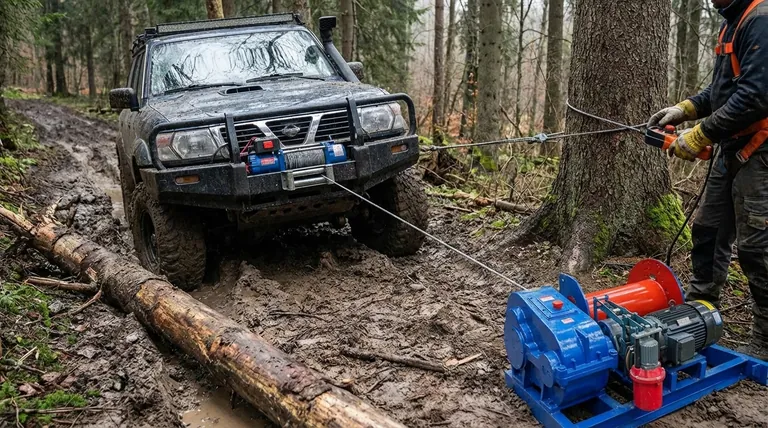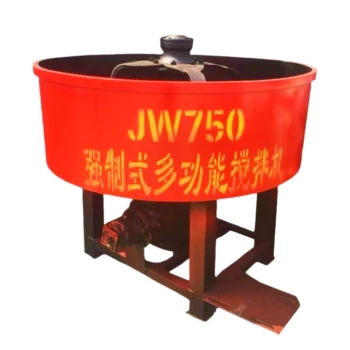At its core, a winch is a powerful recovery tool used to pull a vehicle out of a situation where it can no longer move under its own power. Its primary functions are self-recovery from obstacles like mud, snow, or sand, assisting in the recovery of other vehicles, and clearing heavy objects that are blocking a path.
A winch is best understood not just as a recovery device, but as a force multiplier. It grants you the independence to solve problems—from vehicle extraction to heavy-duty work—that would otherwise be impossible without external help.

The Core Functions of a Recovery Winch
A winch's value is most apparent when traction is lost and forward momentum ceases. In these moments, it becomes the most critical tool on the vehicle.
Self-Recovery: Your Primary Insurance Policy
The most fundamental use of a winch is extracting your own vehicle. Whether you are stuck in deep mud, high-centered on rocks, or bogged down in snow or sand, the winch allows you to pull yourself to a stable anchor point.
This is the essential capability for anyone traveling solo or exploring remote areas where professional help is unavailable.
Assisting Other Vehicles
A properly rated winch is also an invaluable tool for recovering another vehicle. When a companion vehicle becomes stuck, you can position your vehicle as a stable anchor and use your winch to safely pull them free.
This transforms a potentially trip-ending event into a manageable recovery operation.
Clearing Obstacles from the Path
Sometimes the vehicle isn't stuck, but the path forward is blocked. A winch is exceptionally useful for moving heavy objects like fallen trees, large boulders, or other debris from a trail.
This function ensures that a blocked route doesn't force a dangerous or lengthy detour.
Loading and Controlled Maneuvering
A winch provides precise, powerful pulling force that is ideal for tasks beyond typical recovery. This includes loading a non-running vehicle onto a trailer or carefully righting an overturned piece of equipment like a small tractor.
Beyond Basic Recovery: The Winch as a Utility Tool
The power of a winch extends far beyond vehicle-centric recovery, making it a versatile tool for work, land management, and other demanding tasks.
Worksite and Land Management
In forestry, farming, or ranching, a winch serves as portable muscle. It can be used to remove tree stumps, pull stubborn fence posts from the ground, or drag logs and other heavy materials into position.
Moving Exceptionally Heavy Objects
For jobs around a property, a winch can be used to relocate large rocks, help adjust the position of a small outbuilding, or provide the necessary force to precisely fell a tree in a specific direction with proper rigging.
Common Pitfalls to Avoid
While incredibly capable, a winch's effectiveness and safety depend entirely on proper understanding and use.
A Winch is Useless Without an Anchor
The single biggest limitation is the need for a solid anchor point. If you are in an open field or desert with nothing to attach the winch line to, it cannot be used. This is why many experienced users carry ground anchors.
The Critical Need for Safety Gear
Winch lines are under thousands of pounds of tension during a recovery. A snapped line can be catastrophic. Using a winch line damper, heavy-duty gloves, and rated shackles is not optional—it is essential for safe operation.
The Strain on Your Vehicle's Electrical System
Electric winches draw a significant amount of amperage, placing a heavy load on your vehicle's battery and alternator. Performing multiple, heavy pulls without letting the system recharge can drain your battery, leaving you stranded for a different reason.
How to Apply This to Your Goal
Your primary reason for needing a winch will determine how you value its different functions.
- If your primary focus is off-road exploration: You need a winch for the core certainty of self-recovery and the ability to clear blocked trails.
- If your primary focus is work and utility: You will leverage the winch as a force multiplier for farming, logging, or property management tasks where raw pulling power is required.
- If your primary focus is general preparedness: You see the winch as an all-purpose "get out of trouble" tool for any number of unpredictable situations, from recovering vehicles to emergency debris removal.
Ultimately, installing a winch is an investment in capability and self-reliance.
Summary Table:
| Primary Use | Key Function | Ideal For |
|---|---|---|
| Self-Recovery | Extracting your own vehicle from mud, snow, or sand. | Solo off-road explorers, remote travelers. |
| Assisting Others | Safely recovering another stuck vehicle. | Group off-roading, team-based work sites. |
| Clearing Paths | Moving fallen trees, boulders, or debris from a trail. | Trail maintenance, emergency response. |
| Utility Work | Pulling stumps, dragging logs, moving heavy objects. | Farming, forestry, land management, construction. |
Ready to invest in self-reliance and power for your projects?
GARLWAY specializes in providing robust and reliable construction machinery, including heavy-duty winches, concrete mixers, and batching plants, designed for the toughest conditions. Whether you're a construction company, a contractor, or an off-road enthusiast, our equipment delivers the power and durability you need to get the job done safely and efficiently.
Contact us today to find the perfect winch for your vehicle or explore our full range of machinery. Let GARLWAY be your partner in capability.
Visual Guide

Related Products
- Electric and Hydraulic Winch for Heavy Duty Applications
- Warn Winch Windlass Boat Trailer Winch
- Electric 120V Boat Winch by Badlands
- Best 18000 Pound Drum Anchor Trailer Winch
- 12000 lb Heavy Duty Electric Boat Winch
People Also Ask
- Do electric winches have brakes? Essential Safety for Your Heavy-Duty Pulling
- What is the difference between electric winch and electric hoist? Essential Safety & Application Guide
- How do I choose an electric winch? A guide to safe and effective pulling power.
- How to power an electric winch on a trailer? Choose the Best Method for Your Setup
- How is an electric winch powered? Unlock the Power Conversion System for Heavy Lifting



















